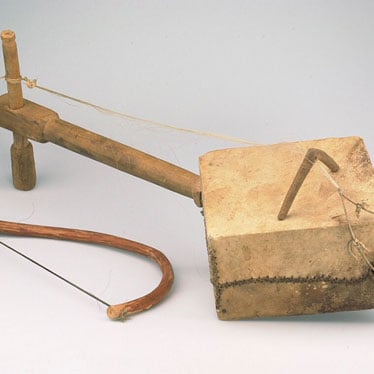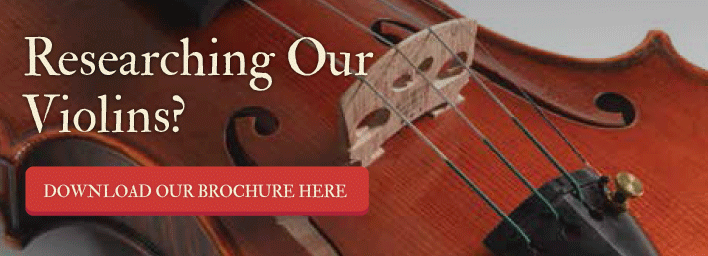Musical Styles: 6 Bowed String Instruments You've Never Heard Of

The violin and its string family — the viola, cello, and bass — are not the only string instruments that are played with a bow. All over the world, bowed string instruments can find that date back centuries within their respective cultural traditions.
Take a look at these six examples. And check out the videos. You may find some inspiration, and at the very least, be surprised.
1. Erhu
The erhu or “spike fiddle” is the most common of the Huqin family of bowed string instruments popular in Chinese music. It is an extremely expressive instrument made of rose or red sandalwood. It sports a round or octagonal sound box at the bottom with a long thin neck with two tuning pegs, one for each of the two strings. There is no fingerboard like the violin, so the player's fingers must hold and vibrate the strings by pressing only against the strings themselves.
The sound box (drum resonator) is typically covered with python snakeskin on one side and ornamental wood on the other. The erhu’s bow is made of horse tail hair and bamboo, and is mounted between the two strings and can’t be taken out. The erhu is an alto or middle range instrument with a history of almost 4,000 years.
Check out this video of an erhu accompanied by piano:
2. The Morin Khuur
Also known as the horsehead fiddle, it is one of the most important musical instruments of the Mongol people. This traditional Mongolian bowed stringed instrument is considered a symbol of the Mongolian nation and one of the Masterpieces of the Oral and Intangible Heritage of Humanity identified by UNESCO. Many festivals are held in celebration of the morin khuur, and Mongolians often have the box-shaped wooden instrument with two strings in their home, as it is seen as a symbol of peace and happiness. The strings are constructed from horses' tails and strung over a wooden bridge on the body and up a long neck, past a second smaller bridge, to two tuning pegs on the scroll, which is often carved in the shape of a horse head. The bowing technique is unique, as it uses the little and the ring finger of the right hand to touch the bow hair for sound accents. The other two fingers maintain a slight pressure on the strings.
The popular legend of the morin khuur's origin is of a boy named Sükhe, whose prized white horse was killed by a wicked lord. The horse's spirit came to Sükhe in a dream and instructed him to make an instrument from its body, so the two could be together forever. Sükhe created the first morin khuur with the horse’s bones as the neck of the instrument, along with horsehair strings, horse skin covering the wooden soundbox, and the scroll carved like a horse’s head.
Watch the video to hear traditional morin khuur music, often accompanied by throat singing.
3. Nyckelharpa
This traditional Swedish musical instrument, also known as a chordophone, dates back to the 16th Century. The modern nyckelharpa has 16 strings ¬– three melody strings, a drone string, and twelve resonance strings. It has 37 wooden keys arranged to slide under the strings, attached to tangents which, when depressed, serve as frets to change the pitch of the string. A short bow is used in the right hand while the left hand pushes on the keys. It has a three-octave range and sounds something like a fiddle, only with more resonance. You can learn more at the American Nyckelharpa Association.
Check out Thomas Roth on this fascinating instrument:
4. Gadulka
The Bulgarian gadulka is an integral part of Bulgarian traditional instrumental ensembles, commonly played in the context of dance music. Its name means "to make noise, hum, or buzz." The gadulka’s strings are steel. It has three melody strings and up to 16 sympathetic strings that give resonance to the tones, which are obtained by gliding the strings with a bow made of a flexible forked willow twig and tied with horse hair and waxed with rosin. Unlike many other stringed instruments, there is no nut at the top of the strings – they are stretched between a tuning peg at the top and the tailpiece at the bottom, passing over the bridge or through holes in the bridge.
Here’s a fun video where one gadulka player really goes for it!
5. Mesenqo
In the musical tradition of Ethiopia, we find the Mesenqo – a single-stringed bowed lute. The instrument is often used by Ethiopian minstrels, called azmaris ("singer" in Amharic). The masenqo requires great virtuosity, as the azmaris sings while playing.
The diamond-shaped box is made of four small wooden boards glued together and covered with a stretched parchment or rawhide. The single string is typically made of horse hair and passes over the bridge. The instrument is tuned with a large tuning peg to fit the range of the singer's voice. It may be bowed by either the right or left hand, while the other hand sits on top of the upper part of the string.
6. Bowed Psaltery
A 20th-century invention, the bowed psaltery is a type of psaltery or zither with a wooden soundbox with unstopped strings over the soundboard. It is significantly different from a medieval plucked psaltery in that its strings are arranged to allow it to be played with a bow. It is triangular in shape, with each string extending a bit farther than the one before it, so that each can be individually played. Chromatic bowed psalteries have sharps and flats on one side and the diatonic notes on the opposite. The soundboard has a soundhole or rose in the center.
The instrument can be played either one note at a time, being held with one hand and bowed with the other, as in instruments of the violin family, or it can be laid flat and played with a bow in each hand, similar to the hammered dulcimer. Some players will also hold two bows in one hand to facilitate double-stopping. It can also be strummed or struck for additional tone colors.
Watch Gregg Schneeman play a beautiful double-bowed song on the psaltery:


